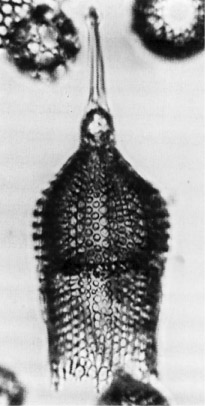 Theocyrtis
annosa (Riedel)
Theocyrtis
annosa (Riedel) Theocyrtis
annosa (Riedel)
Theocyrtis
annosa (Riedel)Phormocyrtis annosa Riedel, 1959, p.295, pl.2, fig.7
Calocycletta annosa (Riedel) Petrushevskaya and Kozlova, 1972, p.544
Theocyrtis annosa (Riedel), Riedel and Sanfilippo, 1970, p.535
Cephalis elongate, lobate, with a few small pores, surmounted by a stout three-bladed horn. Thorax inflated-campanulate, with regular circular pores.
Thoracic wall pronouncedly plicate longitudinally, the plicae being separated by three to five longitudinal rows of pores. Abdomen subcylindrical, with a thinner wall than the thorax, and sub-circular to circular pores usually less regularly arranged than in the thorax. In most specimens the thoracic plicae extend into the abdomen, where they become less distinct. Termination of the abdomen usually ragged, but in some specimens with approximately eight to fifteen parallel, triangular lamellar feet or teeth. This species differs from all others of the genus in having a thick-walled, pronouncedly plicate thorax (Riedel, 1959).
The thorax of this species is not tuberose, but has pronounced longitudinal plicae spaced in such a way that each separates several longitudinal rows of pores. This species is not to be confused with the superficially similar form that is evidently ancestral to T. tuberosa. Throughout and beyond the ranges of both T. tuberosa and T. annosa, occurs a generalized type of Theocyrtis with unornamented shell wall (Riedel and Sanfilippo, 1978a).
Longitudinal plicae in the wall of the thorax (and often also of the abdomen), which separate 2-6 rows of pores, distinguish this species from practically all other pterocorythids. The only exception, with which Theocyrtis annosa may be confused, is an early form of T. tuberosa, prior to the development of pronounced tubercles on the thorax of that species. These two forms are so similar that they can be confidently identified only when the age of the assemblage is known (Sanfilippo et al., 1985).
The most notable variation in this smoothly contoured, broadly spindle-shaped form is a marked increase in size from early to late specimens. Near the beginning of its stratigraphic range the total length of cephalis plus thorax is usually 115-135 µm and the maximum width of the thorax is 110-125 µm, while near the end of its range these dimensions are about 180-210 µm and 170-185 µm, respectively. Throughout its range, the length of the stout, bladed apical horn is commonly 35-75 µm, and the length of the abdomen 25-90 µm. The thorax varies in degree of inflation, from campanulate to inflated-conical. The abdomen in late specimens often terminates in 8-15 small triangular teeth, and it is not known whether their absence in early specimens is a result of poor preservation (Sanfilippo et al., 1985)
This species is a common member of assemblages of late late Oligocene to early early Miocene age in low and middle latitudes, including the Mediterranean region. Its morphotypic first appearance lies within the Dorcadospyris ateuchus Zone. Its morphotypic last appearance defines the base of the Stichocorys delmontensis Zone.
It seems clear that Theocyrtis annosa evolved from T. tuberosa, though there appears to be a short gap between their stratigraphic ranges at some localities (Riedel and Sanfilippo, 1973).
The [earliest occurrence] of this species may have been recorded at Site 289 at a level that is relatively lower than that previously recorded. Three variants are tabulated:
Theocyrtis annosa Form A. The earliest T. tuberosa Zone specimens: very delicately ribbed, usually rare and often represented by only fragmentary specimens.
Theocyrtis annosa Form B. Specimens with more pronounced ribbing and a suggestion that the shell is molded into broad, raised, longitudinal segments--identical with Riedel and Sanfilippo, 1971, pl.3D, fig.13. The first appearance is higher than the morphotypic base of Form A.
Theocyrtis annosa Form C. Larger specimens, lacking the suggestions of longitudinal segmentation, identical with Riedel and Sanfilippo, 1971, pl.2H, fig.4; pl.3D, fig.12. The first appearance is higher again than that of Form B, and it is probable that only Form C persists to the extinction level of T. annosa group. In the highest part of its range Form C shows a tendency to reduction in rib strength and reversion to a morphotype somewhat similar to Form A (Holdsworth, 1975).